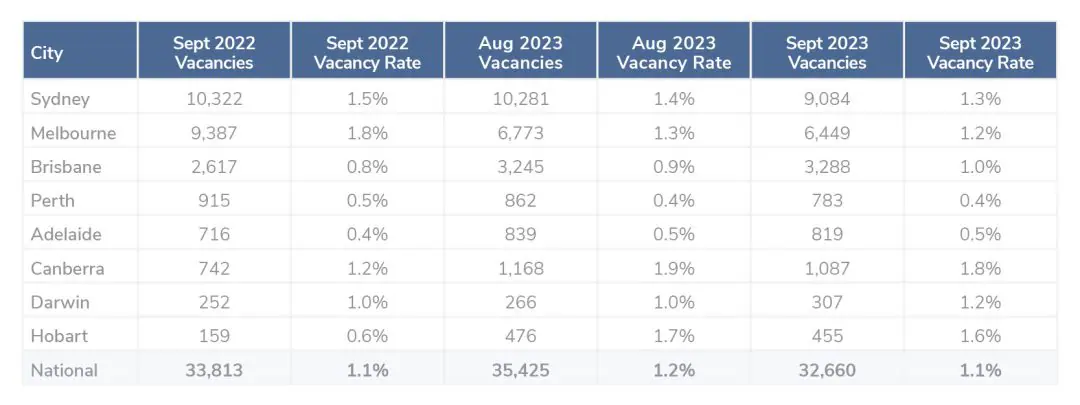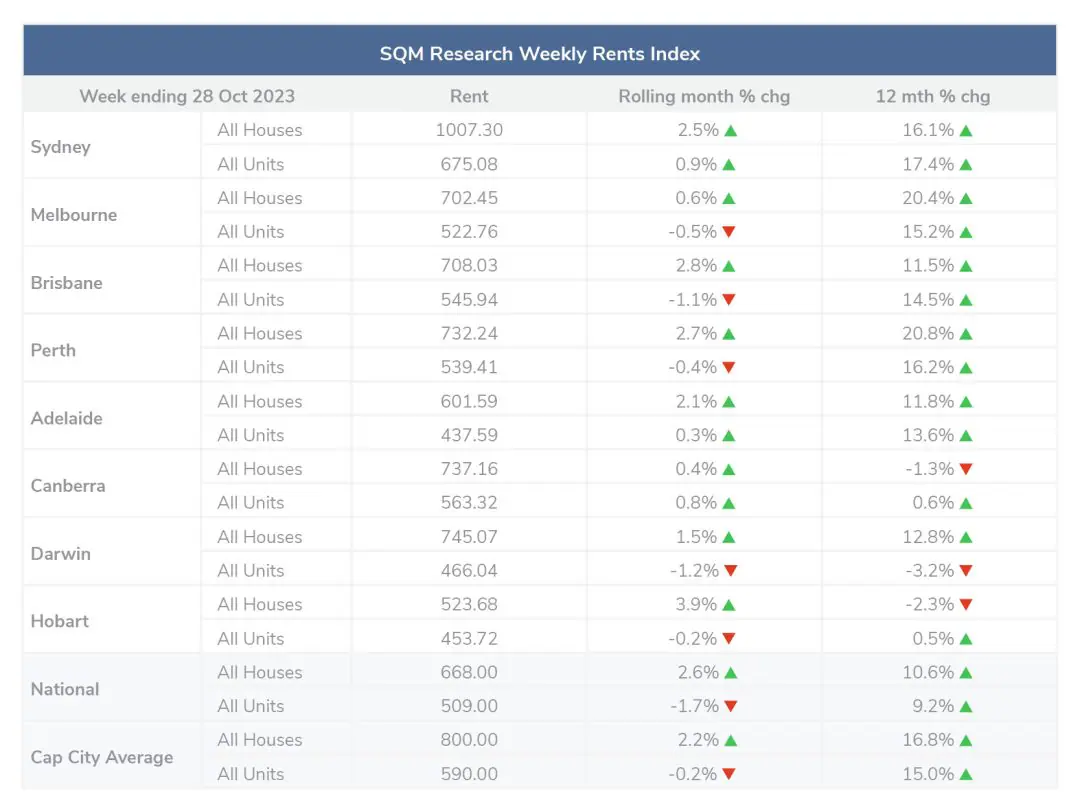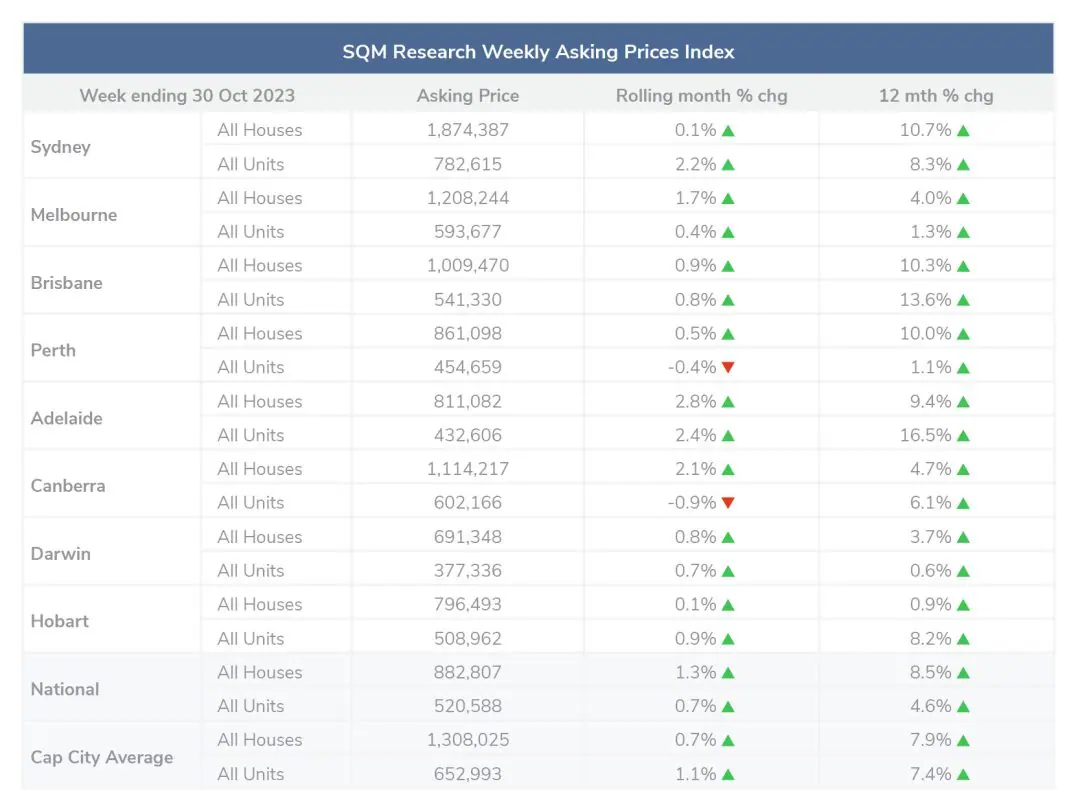October property market update (2023)
- Posted By Nikki Montaser
National rental vacancy rates fell for a second consecutive month to 1.1% in September and weekly asking prices rose by 2.6% for houses and decreased -1.7% for units. New listings increased by 2.7% nationally and national asking prices increased by 1.3% for houses and 0.7% for units.
Vacancy rates
National rental vacancy rates fell to 1.1% in September, the second consecutive drop after a brief stabilisation. The total number of vacancies decreased in September by 2,765 dwellings, bringing the total number of vacancies to 32,660.
The tightening was experienced Australia-wide, with most capital cities, capital city CBDs and regional areas reporting decreases in vacancy rates, 77.6% of all postcodes recorded a fall in rental vacancy rates.
Louis Christopher, Managing Director of SQM Research said, “Current net overseas arrivals are suggesting the population is expanding at an annual rate of some 650,000 people, which obviously is keeping pressure on the national rental market, especially given approximately 175,000 new dwellings have been completed for the past 12 months.
What is also noteworthy in September was the return to very tight rental conditions for Australia’s regional townships. It would suggest the population overflow is making many look once more to areas outside the capital cities in order to find shelter. Going forward, the market may find some seasonal relief after October, however, it is unlikely rental growth will pause.”

Rental values
Over the past 30 days to 28 October 2023, national weekly asking prices rose by 2.6% for houses and decreased -1.7% for units. The capital city average weekly rent increased by 2.2% for houses and decreased by -0.2% for units.
Compared to last year, the national asking prices increased by 10.6% for houses and 9.2% for units. The capital city average asking price increased by 16.8% for houses and 15% for units.
On 28 October 2023, the national median weekly asking rent was $668 per week for a house and $509 per week for a unit. The median capital city asking rent for a house was $800 per week for a house and $590 per week for a unit.

Property prices
National total property listings decreased by a marginal -0.9% in October, primarily attributed to the substantial reduction in older listings across major cities.
Compared to this time last year, national total listings have increased by 3%, with significant variations across major cities.
Increases were reported for Sydney at 3.6%, Melbourne at 5%, Canberra at 12.4%, Darwin at 0.7% and Hobart at 26.1%. Decreases were reported for Brisbane at -12.1%, Perth at -21.3% and Adelaide at -2.8%.
New listings increased by 2.7% in October, with an additional 79,722 dwellings coming to market. With decreases seen in Sydney and Darwin at 2.3% and 1.5%, respectively. Contrastingly Hobart and Melbourne, Canberra and Adelaide experienced significant increases at 8.4%, 7.6%, 4.5% and 3.7%, respectively.
SQM Research’s latest report reveals that “as of October 2023, the number of residential properties being sold under distressed conditions in Australia has risen to 5,521. This reflects an increase of 5.2% compared to the 5,246 distressed listings recorded in September 2023.”
In October national asking prices increased by 1.3% for houses and 0.7% for units and capital city average asking prices increased by 0.7% for houses and 1.1% for units. Combined national asking prices for all dwellings (houses and units) reached a record high of $805,683.
Compared to this time last year, national asking prices have increased by 8.5% for houses and 4.6% for units, and capital city average asking prices have increased by 7.9% for houses and 7.4% for units.
Louis Christopher, Managing Director of SQM Research said, “Despite the school holiday period, Grand Finals, listing counts maintained the robust levels recorded in spring. And given what we know about seasonality for this time of year, I am expecting a significant rise in listings for the month of November. It is interesting we recorded a sizeable fall in older listings, which implies stock absorption rates were up in October. But I also note the rise in distressed listings, which is a negative for the market if it were to continue to rise from these levels. Overall, vendors remained confident for the month as displayed by the new record high in asking prices. We will see how they respond on any further rate rise at next week’s RBA board meeting.”

Cash rate
September saw the RBA hold the cash rate target at 4.10%.
Disclaimer: The information enclosed has been sourced from SQM Research and Reserve Bank of Australia, and is provided for general information only. It should not be taken as constituting professional advice.
PropertyMe is not a financial adviser. You should consider seeking independent legal, financial, taxation, or other advice to check how the information relates to your unique circumstances.
Article posted by Property Me.

